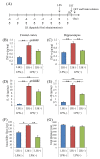Leucine-Histidine Dipeptide Attenuates Microglial Activation and Emotional Disturbances Induced by Brain Inflammation and Repeated Social Defeat Stress
- PMID: 31505850
- PMCID: PMC6770249
- DOI: 10.3390/nu11092161
Leucine-Histidine Dipeptide Attenuates Microglial Activation and Emotional Disturbances Induced by Brain Inflammation and Repeated Social Defeat Stress
Abstract
The number of patients with mental illnesses is rapidly increasing, and daily lifestyle is closely associated with the development of symptoms. It is suggested that inflammatory molecules derived from microglia play crucial roles for the pathophysiology of depression. In the present study, we discovered that leucine-histidine (LH) dipeptide suppressed activation of primary microglia. The effects of LH dipeptide orally administered were measured using tail suspension test (TST) in mice injected with lipopolysaccharide and social interaction test in mice received social defeat stress. LH dipeptide reduced pro-inflammatory cytokines upon stimulation in microglia. Orally administered LH dipeptide was delivered to the brain and suppressed the production of pro-inflammatory cytokines in the brain and concomitant depression-like behavior in the TST. Moreover, oral administration of LH dipeptide suppressed the induction of depression- and anxiety-like behaviors induced by repeated social defeat stress. These results indicate that LH dipeptide suppressed the activation of microglia and ameliorated depression-associated emotional disturbances. Further, we found that LH dipeptide was abundant in various fermented products. Together with previous epidemiological reports that daily intake of these fermented foods is negatively associated with the incidence of psychiatric diseases, our findings suggest that food rich in LH dipeptide may improve mental health.
Keywords: antidepressant; cytokine; dipeptide; inflammation; microglia.
Conflict of interest statement
Ano, Y. and Kita, M. are employed by Kirin Holdings Co. Ltd. All other authors declare no competing interests.
Figures




Similar articles
-
Antidepressant effect of the translocator protein antagonist ONO-2952 on mouse behaviors under chronic social defeat stress.Neuropharmacology. 2020 Jan 1;162:107835. doi: 10.1016/j.neuropharm.2019.107835. Epub 2019 Nov 1. Neuropharmacology. 2020. PMID: 31682855
-
β-Adrenergic receptor antagonism prevents anxiety-like behavior and microglial reactivity induced by repeated social defeat.J Neurosci. 2011 Apr 27;31(17):6277-88. doi: 10.1523/JNEUROSCI.0450-11.2011. J Neurosci. 2011. PMID: 21525267 Free PMC article.
-
Kososan, a Kampo medicine, prevents a social avoidance behavior and attenuates neuroinflammation in socially defeated mice.J Neuroinflammation. 2017 May 3;14(1):98. doi: 10.1186/s12974-017-0876-8. J Neuroinflammation. 2017. PMID: 28468634 Free PMC article.
-
Peripheral and central effects of repeated social defeat stress: monocyte trafficking, microglial activation, and anxiety.Neuroscience. 2015 Mar 19;289:429-42. doi: 10.1016/j.neuroscience.2015.01.001. Epub 2015 Jan 14. Neuroscience. 2015. PMID: 25596319 Free PMC article. Review.
-
Roles of multiple lipid mediators in stress and depression.Int Immunol. 2019 Aug 23;31(9):579-587. doi: 10.1093/intimm/dxz023. Int Immunol. 2019. PMID: 30810163 Review.
Cited by
-
Comprehensive Circulatory Metabolomics in ME/CFS Reveals Disrupted Metabolism of Acyl Lipids and Steroids.Metabolites. 2020 Jan 14;10(1):34. doi: 10.3390/metabo10010034. Metabolites. 2020. PMID: 31947545 Free PMC article.
-
Long-Term Effects of Repeated Social Defeat Stress on Brain Activity during Social Interaction in BALB/c Mice.eNeuro. 2022 May 3;9(3):ENEURO.0068-22.2022. doi: 10.1523/ENEURO.0068-22.2022. Print 2022 May-Jun. eNeuro. 2022. PMID: 35437264 Free PMC article.
-
Regional Brain Analysis of Modified Amino Acids and Dipeptides during the Sleep/Wake Cycle.Metabolites. 2021 Dec 27;12(1):21. doi: 10.3390/metabo12010021. Metabolites. 2021. PMID: 35050142 Free PMC article.
-
Enhancement of memory and emotional functions by long-term ingestion of protease-treated porcine liver extract in mice.Sci Rep. 2025 May 28;15(1):18694. doi: 10.1038/s41598-025-03362-4. Sci Rep. 2025. PMID: 40436945 Free PMC article.
-
919 Syrup Alleviates Postpartum Depression by Modulating the Structure and Metabolism of Gut Microbes and Affecting the Function of the Hippocampal GABA/Glutamate System.Front Cell Infect Microbiol. 2021 Aug 20;11:694443. doi: 10.3389/fcimb.2021.694443. eCollection 2021. Front Cell Infect Microbiol. 2021. PMID: 34490139 Free PMC article.
References
-
- World Health Organization Depression Fact Sheet. [(accessed on 12 June 2019)];2016 Volume 369. Available online: http://www.who.int/en/news-room/fact-sheets/detail/depression.
-
- Thase M.E., Friedman E.S., Biggs M.M., Wisniewski S.R., Trivedi M.H., Luther J.F., Fava M., Nierenberg A.A., McGrath P.J., Warden D., et al. Cognitive therapy versus medication in augmentation and switch strategies as second-step treatments: a STAR*D report. Am. J. Psychiatry. 2007;164:739–752. doi: 10.1176/ajp.2007.164.5.739. - DOI - PubMed
MeSH terms
Substances
Grants and funding
LinkOut - more resources
Full Text Sources
Medical

